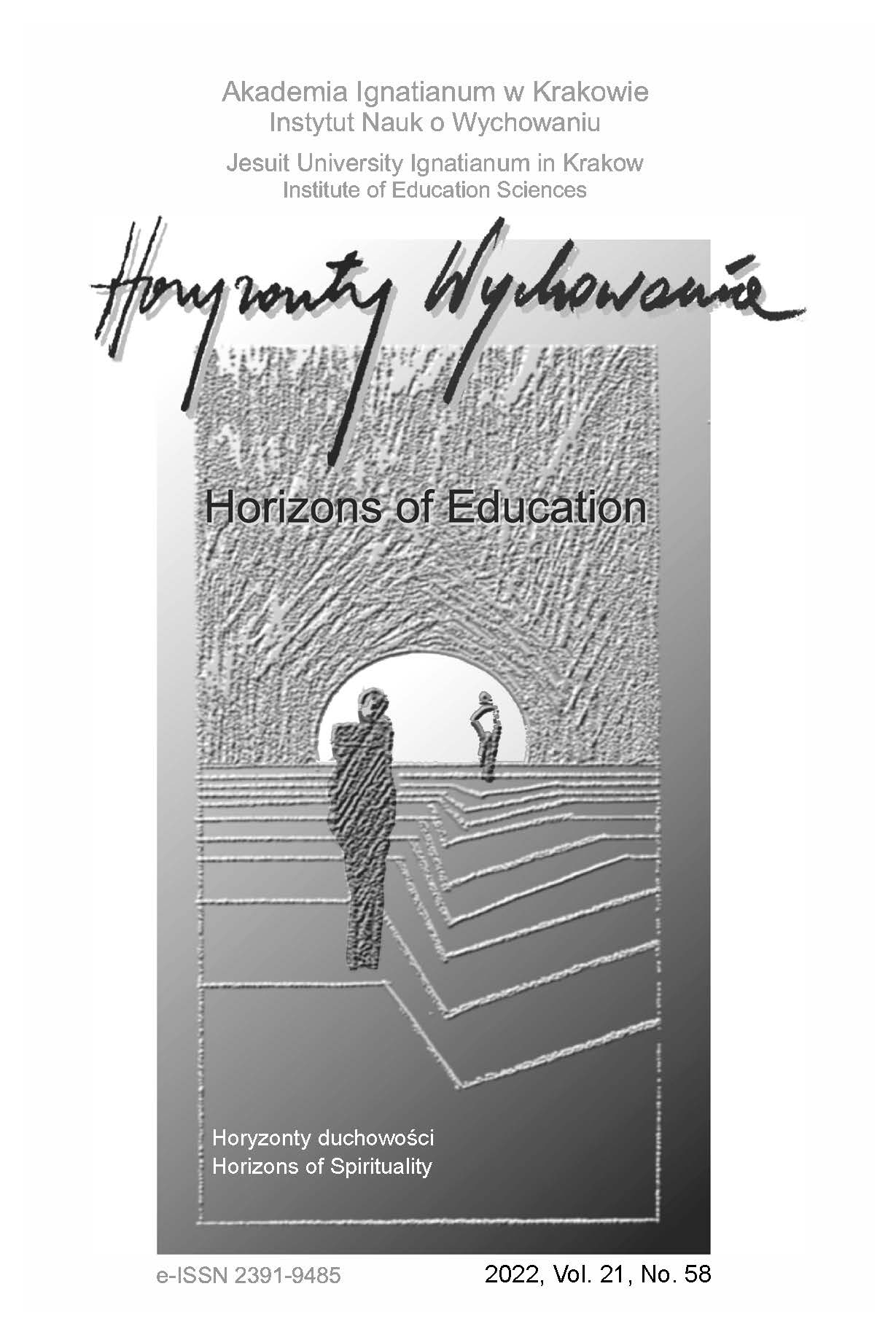A Model of Multidimensional Positive Prevention as an Example of Measures to Support the Spiritual Development of Children and Adolescents
Abstract
RESEARCH OBJECTIVE: The aim of this paper is to present a model of multidimensional posi‑
tive prevention as an example of measures that can support the spiritual development of children
and adolescents.
RESEARCH PROBLEM AND METHODS: The research problem focuses on finding an answer
to the question whether and how the model of multidimensional positive prevention can support the
spiritual development of children and adolescents, and what practical implications can be drawn
from the theoretical and empirical assumptions of the model. The author uses the analytical-syn‑
thetic method, based on the selected literature on the subject.
THE PROCESS OF ARGUMENTATION: On the basis of the literature on the subject, the author
analyzes the noetic and spiritual dimension of existence showing its significance for constructing
effective preventive activity. Theoretical and empirical assumptions of the model of multidimensional
positive prevention are also presented.
RESEARCH RESULTS: The conducted analyzes indicates that the model of multidimensional
positive prevention assumes designing the preventive activities supporting the development of pro‑
tective factors in all dimensions of existence. At the same time, it focuses on its noetic and spiritual
dimension, what is particularly important in
the case of children and adolescents from dysfunctional and pathological families.
CONCLUSIONS, INNOVATIONS AND RECOMMENDATIONS: The model of multidimensional
positive prevention is a comprehensive construct that comprises theoretical and empirical assump‑
tions, on the basis of which prevention programmes can be designed to support the spiritual devel‑
opment of children and adolescents. The designation of the model in pedagogical practice is the
prevention programme “Support for the Multidimensional Development of Youth,”The empirical assumptions
of the model enable to designe programmes in the area of universal and selective prevention. The
students of educational institutions, special education centres and juvenile care facilities can be
the potential recipients of these programmes.
References
Delors, J. (red.), (1998). Edukacja – jest w niej ukryty skarb. Raport dla UNESCO Międzynarodowej Komisji do spraw Edukacji dla XXI wieku (W. Rabczuk, tłum.). Stowarzyszenie Oświatowców Polskich, Wydawnictwo UNESCO.
Frankl, V.E. (1978). Homo patiens (R. Czernecki i J. Morawski, tłum.). Instytut Wydawniczy Pax.
Frankl, V.E. (2009). Człowiek w poszukiwaniu sensu (A. Wolnicka, tłum.). Wydawnictwo Czarna Owca.
Frankl, V.E. (2010). Wola sensu. Założenie i zastosowanie logoterapii (A. Wolnicka, tłum.). Wydawnictwo Czarna Owca.
Frankl, V.E. (2012). Bóg ukryty. W poszukiwaniu ostatecznego sensu (A. Wolnicka, tłum.). Wydawnictwo Czarna Owca.
Gaś, Z.B. (2004). Szkolny program profilaktyki: istota, konstruowanie, ewaluacja. Poradnik metodyczny. Pracownia Wydawnicza Fundacji „Masz Szansę”.
Hejnicka-Bezwińska, T. (2008). Pedagogika ogólna. Wydawnictwa Akademickie i Profesjonalne.
Jarosz, K. (2019a). Model wielowymiarowej profilaktyki pozytywnej w teorii i praktyce pedagogicznej. W: Z.B. Gaś (red.), Profilaktyka zachowań ryzykownych w teorii i praktyce (s. 53-71). Wyższa Szkoła Ekonomii i Innowacji w Lublinie.
Jarosz, K. (2019b). Profilaktyka pozytywna w teorii i praktyce pedagogicznej. Wydawnictwo Uniwersytetu Opolskiego.
Kamińska, A. (2018). Założenia logoteorii Viktora Emila Frankla a wychowanie człowieka. Zeszyty Naukowe Wyższej Szkoły Humanitas. Pedagogika, 18, 23-35.
Kwieciński, Z. (1996). Edukacja do globalnego przetrwania i rozwoju. W: K. Pacławska (red.), Tradycja i wyzwania. Księga pamiątkowa na 70-lecie założenia Studium Pedagogicznego Uniwersytetu Jagiellońskiego 1921-1996 (s. 89-99). Towarzystwo Autorów i Wydawców Prac Naukowych Universitas.
Ostaszewski, K. (2014). Zachowania ryzykowne młodzieży w perspektywie mechanizmów resilience. Instytut Psychiatrii i Neurologii.
Ostaszewski, K. (2016). Pozytywna profilaktyka po 10 latach. Świat Problemów, 1(276), 5-10.
Popielski, K. (1989). Koncepcja logoteorii V.E. Frankla i jej znaczenie w poradnictwie psychologiczno-pastoralnym. W: Z. Chlewiński (red.), Wybrane zagadnienia z psychologii pastoralnej(s. 69-101). Redakcja Wydawnictw KUL.
Popielski, K. (1994). Noetyczny wymiar osobowości. Psychologiczna analiza poczucia sensu życia. Redakcja Wydawnictw KUL.
Popielski, K. (2008). Poczucie sensu życia jako doświadczanie egzystencjalnie znaczące i potrzeba rozwojowa. W: M. Dudzikowa i M. Czerepaniak-Walczak (red.), Wychowanie. Pojęcia – procesy – konteksty (s. 19-51). Gdańskie Wydawnictwo Psychologiczne.
Ruczaj, A. (2020). Logoterapia w kontekście suicydologii: wykorzystanie logoteorii w wyjaśnianiu i prewencji samobójstw, cz. 1. Kwartalnik Naukowy Fides Et Ratio, 44(4), 322-333. https://doi.org/10.34766/fetr.v44i4.420
Szulc, A. (2013). W poszukiwaniu utraconego sensu. Człowiek współczesny jako HOMO PATIENS. Seminare. Poszukiwania Naukowe, 34, 97-111.
Copyright (c) 2022 HORIZONS OF EDUCATION

This work is licensed under a Creative Commons Attribution-NoDerivatives 4.0 International License.
Authors who publish in this journal agree to the following terms:
- Authors retain the copyright to their work while granting the journal the right of first publication. The work will be simultaneously licensed under a CC BY-ND license, which permits others to share the work with proper credit given to the author and the original publication in this journal.
- Authors may enter into additional, non-exclusive agreements for the distribution of the published version of the work (e.g., posting it in an institutional repository or publishing it in another journal), provided that the original publication in this journal is acknowledged.
We allow and encourage authors to share their work online (e.g., in institutional repositories or on personal websites) both before and during the submission process, as this can foster beneficial exchanges and lead to earlier and increased citations of the published work. (See The Effect of Open Access). We recommend using any of the following academic networking platforms:





